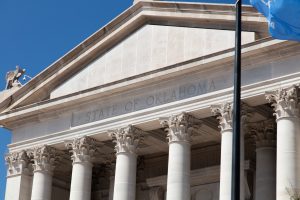Oklahoma Bar Journal
First Among Equals: The Division of Executive Power Between the Governor and the Attorney General
By John Tyler Hammons
 The governor of Oklahoma is the “chief magistrate” of the state government,[1] directly elected by the people of Oklahoma and charged by the Oklahoma Constitution with the duty of “caus[ing] the laws of the State to be faithfully executed.”[2] The people also elect an attorney general, whom the Legislature has declared the “chief law officer of the state,”[3] with statutory authority to “take and assume control” of any litigation involving the state.[4] These competing authorities inevitably lead to conflict between Oklahoma’s top executive officials. The proper division of power between the governor and the attorney general is no mere matter of arcane political interest. It is a question of paramount constitutional significance that directly impacts the liberty of all Oklahomans.
The governor of Oklahoma is the “chief magistrate” of the state government,[1] directly elected by the people of Oklahoma and charged by the Oklahoma Constitution with the duty of “caus[ing] the laws of the State to be faithfully executed.”[2] The people also elect an attorney general, whom the Legislature has declared the “chief law officer of the state,”[3] with statutory authority to “take and assume control” of any litigation involving the state.[4] These competing authorities inevitably lead to conflict between Oklahoma’s top executive officials. The proper division of power between the governor and the attorney general is no mere matter of arcane political interest. It is a question of paramount constitutional significance that directly impacts the liberty of all Oklahomans.
SEPARATION OF POWERS
The republic of Oklahoma has endured for over a century because of its governmental structure. The state’s founding fathers believed the separation of governmental power was essential to securing freedom.[5] Although this principle is visible in the traditional separation of powers into legislative, executive and judicial branches, the state constitution provides a double layer of protection. Not only is power at the state government level divided externally between the three branches,[6] it is also divided internally between the officers who make up those branches. This internal division of power is a fundamental principle of constitutional order. When the constitution prescribes a particular function is to be performed by a given officer, then the “exercise and discharge [of that function] by any other officer [is] forbidden.”[7] Allowing an officer to perform functions not pertaining to their office causes “the whole constitutional fabric [to be] undermined and destroyed.”[8]
The constitution’s double layer of protection is most evident through the structure of the state’s executive branch. In contrast to the unitary executive of the U.S. Constitution that vests all executive power in the president of the United States alone,[9] Oklahoma employs a plural executive, in which executive power is dispersed between 11 statewide elected officials, among them being the governor and the attorney general.[10] Under this structure, the constitution “confer[s] upon [the attorney general] certain powers and duties independent of the Governor.”[11] The attorney general is neither “the agent of the Governor”[12] nor is it within the governor’s power “to prevent [the attorney general] from discharging any duty imposed upon him by virtue of the constitution or the statutory law.”[13] Complicating Oklahoma’s plural executive, however, is the unique role the state’s founding fathers assigned to the governor. While the governor and the attorney general are both vested with a portion of the executive power, the constitution gives the “supreme executive power” to the governor alone.[14]
THE POWER OF THE GOVERNOR
The precise limits of the governor’s “supreme executive power” have never been fully defined, with disagreements over its scope being “nothing new.”[15] In July 1908, a mere eight months after the adoption of the state constitution, the first governor asserted his authority over the first attorney general. In State ex rel. Haskell v. Huston, the governor sought to dismiss a lawsuit initiated by the attorney general.[16] A unanimous Supreme Court sided with the governor, ruling the attorney general could not initiate any lawsuits without first obtaining the governor’s consent.[17] Observing that “the Constitution nowhere designated the duties of the Attorney General,” the court held the attorney general could only exercise those powers that were consistent with state statute.[18] Although agreeing that the attorney general possessed broad common law prerogatives, the court ruled the constitution did not protect those powers against legislative alteration, diminishment or abolition.[19] Because the relevant statute restricted the attorney general from initiating lawsuits on his own motion,[20] the attorney general’s common law powers were abrogated and his actions declared unlawful.[21]
The governor’s constitutional position differs significantly from the attorney general in this regard. While the constitution declares only with “paucity ... the duties of the state’s Attorney General,”[22] it extensively defines the role of the governor. Among the other duties assigned to that office, the constitution leaves no speculation as to whom is to administer the laws enacted by the Legislature: The governor is singularly charged with this task.[23] Unlike the attorney general, whose powers may be freely altered by legislative enactment,[24] the governor’s investiture of the “supreme executive power” preserves to that office “the complete or full-range of executive powers that were recognized at the time the Oklahoma Constitution was adopted” against legislative diminishment.[25] The ability to employ special counsel is one such preserved power, existing even in the absence of explicit statutory authorization.[26] By employing special counsel, the governor can fulfill their constitutional duty to ensure the laws of the state are faithfully executed even when, in the judgment of the governor, the officials typically responsible for their enforcement fail to faithfully perform their duties.[27]
 While the governor’s litigation powers have existed since statehood,[28] the attorney general’s authority in this realm is a relatively recent development. At the time the constitution was adopted, the attorney general was limited to only representing the state in appeals before the Supreme Court or the Court of Criminal Appeals.[29] Although the attorney general could initiate trial court-level suits with the governor’s approval, this authorization merely granted the attorney general “concurrent” rather than “exclusive” power and did not operate “to relieve or to disqualify or to take away” the powers of other relevant officials.[30] This concurrent authority was altered in 1939 when the Legislature revised the attorney general’s statutory responsibilities.[31] Along with designating the attorney general the “chief law officer” of the state for the first time,[32] the 1939 amendments empowered the attorney general to “take and assume control” over any litigation involving the state.[33] This preclusive authority conferred upon the attorney general “complete dominion over every litigation” involving the state absent “explicit legislative or constitutional expression to the contrary.”[34] However, as with the pre-1939 practice, this preclusive authority still required prior authorization from the governor.[35] It was not until 1995 that the attorney general gained the statutory power to initiate a lawsuit – or to assume control over an existing one – on their own motion.
While the governor’s litigation powers have existed since statehood,[28] the attorney general’s authority in this realm is a relatively recent development. At the time the constitution was adopted, the attorney general was limited to only representing the state in appeals before the Supreme Court or the Court of Criminal Appeals.[29] Although the attorney general could initiate trial court-level suits with the governor’s approval, this authorization merely granted the attorney general “concurrent” rather than “exclusive” power and did not operate “to relieve or to disqualify or to take away” the powers of other relevant officials.[30] This concurrent authority was altered in 1939 when the Legislature revised the attorney general’s statutory responsibilities.[31] Along with designating the attorney general the “chief law officer” of the state for the first time,[32] the 1939 amendments empowered the attorney general to “take and assume control” over any litigation involving the state.[33] This preclusive authority conferred upon the attorney general “complete dominion over every litigation” involving the state absent “explicit legislative or constitutional expression to the contrary.”[34] However, as with the pre-1939 practice, this preclusive authority still required prior authorization from the governor.[35] It was not until 1995 that the attorney general gained the statutory power to initiate a lawsuit – or to assume control over an existing one – on their own motion.
CHEROKEE NATION V. UNITED STATES DEPARTMENT OF THE INTERIOR
The Supreme Court resolved the conflict between the governor’s special counsel powers and the attorney general’s post-1995 statutory authority in Cherokee Nation v. United States Department of the Interior.[36] In Cherokee Nation, the governor executed compacts with four tribal governments that purported to permit the compacting tribes to engage in casino operations in Oklahoma.[37] Other tribal governments sued the governor in federal court to block the implementation of such compacts.[38] The governor appointed special counsel to defend the lawfulness of his actions, but the attorney general, citing his post-1995 statutory authority, attempted to oust such special counsel with a view toward confessing error on the part of the governor. The governor objected, arguing his “supreme executive power” prohibited the attorney general from excluding the governor’s involvement in the case. In light of these competing claims, the federal court certified the question of each officer’s authority to represent the state to the state Supreme Court for resolution.[39]
A unanimous Supreme Court ruled in favor of the governor. The court determined the governor’s “supreme executive power” is “more than a mere verbal adornment.”[40] Instead, this investiture “clearly contemplates a hierarchy” within the state’s executive branch “with the Governor at the top.”[41] As the “highest in authority” in the executive branch,[42] the governor has the “final say” on the enforcement of state law.[43] Accordingly, the attorney general’s post-1995 statutory authority cannot “override the Governor’s constitutional role,” with the executive branch’s hierarchy mandating such authority be “subordinate” to the governor’s constitutional prerogative to employ special counsel.[44] Although the attorney general is typically responsible for managing state litigation, the governor “has the right to represent the State’s interests” in litigation if their own views contradict those of the attorney general.[45] This allows the governor to “concurrently” advocate for the state alongside – or in opposition to – the attorney general and, in so doing, fulfill their constitutional duty to ensure the law is faithfully executed.[46] The governor’s unique role as the head of the executive branch, however, does not “nullify the Attorney General’s authority.”[47] Instead, both officials “may act independently” to simultaneously “represent such segments of the State’s interest not represented by the [other].”[48]
CONCLUSION
The power-sharing arrangement between the governor and the attorney general recognized in Cherokee Nation aligns with Oklahoma’s founding fathers’ intention to divide governmental power to better secure liberty. While it might be more efficient for one official alone to speak for the state in litigation, the purpose of the separation of powers is “not to promote efficiency but to preclude the exercise of arbitrary power.”[49] By allowing both the governor and the attorney general to express their competing litigation positions, each side is subjected to rigorous examination. This “inevitable friction ... save[s] the people from autocracy” and preserves constitutional order.[50]
 ABOUT THE AUTHOR
ABOUT THE AUTHOR
John Tyler Hammons is an attorney in Muskogee and a founding partner at Hammons Hamby & Price, who represents municipalities and other governmental clients. Mr. Hammons is a sixth-generation Oklahoman and an enrolled citizen of the Cherokee Nation. He previously served as the 47th mayor of Muskogee, and he currently serves as the city attorney for Checotah, McAlester and Tahlequah and presides as the chief municipal judge in Muskogee.
ENDNOTES
[1] Okla. Const. Art. VI, §2.
[2] Okla. Const. Art. VI, §8, cl. 1.
[3] 74 O.S. §18.
[4] 74 O.S. §18b(A)(3).
[5] Wentz v. Thomas, 1932 OK 636, ¶8, 15 P.2d 65, 109.
[6] Okla. Const. Art. IV, §1.
[7] Trapp v. Cook Construction Co., 1909 OK 259, ¶11, 105 P. 667, 670.
[8] Id. Accord Dank v. Benson, 2000 OK 40, ¶6, 5 P.3d 1088, 1091 (“constitutional order is offended” when power is exercised by the wrong official).
[9] U.S. Const., Art. II, §1, cl. 1 (“The executive Power shall be vested in a President of the United States of America.”); Seila Law LLC v. Consumer Fin. Prot. Bureau, 591 U.S. 197, 213 (2020) (“The entire executive Power belongs to the President alone.”) (internal quotation omitted).
[10] Okla. Const., Art. IV, §1, cl. 1 (“The Executive authority of the state shall be vested in a Governor [and] ... Attorney General.”).
[11] Insurance Co. of North America v. Welch, 1915 OK 914, ¶12, 154 P. 48, 52.
[12] State ex rel. West v. Huston, 1910 OK 259, 113 P. 190, 198. Compare with Seila Law LLC, 591 U.S. at 213 (federal executive officials “must remain accountable to the president, whose authority they weld”) (emphasis added).
[13] State ex rel. Taylor v. Cockrell, 1910 OK 374, ¶3, 112 P. 1000, 1000.
[14] Okla. Const., Art. IV, §2.
[15] Keating v. Edmondson, 2001 OK 110, ¶16, 37 P.3d 882, 889.
[16] 1908 OK 157, 97 P. 982.
[17] Id. at 990.
[18] Id. at 986.
[19] Id. at 995. Accord Trapp, 1909 OK 259, ¶16, 105 P. at 672 (duties assigned by the constitution to specific officers, either expressly or impliedly, may not be altered by the Legislature).
[20] The statute in question was Section 6567 of the Revised Statutes of Oklahoma Territory. Although adopted by the territorial legislative assembly, Section 2 of the schedule attached to the state constitution provided all territorial laws would continue in force and effect unless repugnant to the new constitution or until repealed by the new state Legislature.
[21] Haskell, 1908 OK 157, 97 P. at 986.
[22] State ex rel. Cartwright v. Georgia-Pacific. Corp., 1982 OK 148, ¶6, 663 P.2d 718, 720.
[23] Okla. Const. Art. VI, §8.
[24] Cartwright, 1982 OK 148, ¶10, 663 P.2d at 721.
[25] Vandelay Entm't, LLC v. Fallin, 2014 OK 109, ¶12, 343 P.3d 1273, 1276.
[26] Haskell, 1908 OK 157, 97 P. at 985.
[27] Johnston v. Conner, 1951 OK 262, ¶8, 236 P.2d 987, 990. Accord State ex rel. Murray, for Use & Benefit of Sapulpa State Bank v. Pure Oil Co., 1934 OK 514, 37 P.2d 608 (governor may act to execute the law when usual official fails or refuses to do so).
[28] The governor – through his territorial-era predecessor – has possessed special counsel powers since the organization of Oklahoma Territory in 1890. See Section 6592 of the Revised Statutes of Oklahoma Territory of 1903. This territorial-era provision was subsequently readopted by the state Legislature as 74 OS §6.
[29] Section 6567 of the Revised Statutes of Oklahoma Territory of 1903. This section was subsequently reenacted by the state Legislature as 74 OS §11 (now repealed).
[30] Dupree v. State, 1918 OK CR 31, 171 P. 489, 491.
[31] 1939 OSL 20 (codified as 74 OS §18c).
[32] Id. at §1 (codified as 74 OS §18).
[33] Id. at §3(c) (codified as 74 OS §18b(A)(3)).
[34] State ex rel. Nesbitt v. Dist. Court of Mayes Cnty., 1967 OK 228, ¶17, 440 P.2d 700, 707. Accord State ex rel. Derryberry v. Kerr-McGee Corporation, 1973 OK 132, 516 P.2d 813.
[35] 1939 OSL 20, §3(c) (codified as 74 OS §18b(A)(3)).
[36] 2025 OK 4, ___ P.3d ___.
[37] The federal Indian Gaming Regulatory Act (25 USC §2701 et seq.) allows federally recognized Indian tribes to engage in casino operations if the state in which the casino is located enters a compact with the tribe at issue permitting the same. State approval of such gaming compacts is governed by the Oklahoma State-Tribal Gaming Act. 3A OS §261 et seq.
[38] Cherokee Nation, et al. v. United States Department of the Interior, et al., case pending, Case No. 20-CV-2167-TJK, United States District Court for the District of Columbia (docketed Aug. 6, 2020).
[39] The Oklahoma Revised Uniform Certification of Questions of Laws Act (20 OS §1601 et seq.) allows a federal court to certify an unresolved question of Oklahoma law to the Oklahoma Supreme Court for a definitive answer in order to allow the federal court to correctly apply state law in pending federal cases.
[40] 2025 OK 4, ¶27, ___ P.3d ___. (citing with approval Riley v. Cornerstone Community Outreach, Inc., 57 So. 3d 704 (Ala. 2010)).
[41] Id. at ¶¶24; 28.
[42] Id. at ¶25 (citing with approval State ex rel. Stubbs v. Dawson, 86 Kan. 180, 119 P 360 (Kan. 1911)).
[43] Id. at ¶28.
[44] Id. at ¶27.
[45] Id. at ¶30 (citing Haskell). While reaffirming the governor’s constitutional authority to employ special counsel, the court also noted state statute recognized this power by expressly limiting the attorney general’s powers as they relate to the governor. Cherokee Nation, 2025 OK 4, ¶18, ___ P.3d ___ (citing 74 OS §§6; 18c(A)(4)(a)).
[46] Id. at ¶33.
[47] Id. at ¶54 (citing State ex rel. Howard v. Corporation Commission, 1980 OK 96, 614 P.2d 45) (holding the various constitutional officers in Oklahoma’s plural executive are permitted to concurrently present litigation views that differ from those of the attorney general on matters that affect their own authorities). See also Teleco, Inc. v. Corporation Commission, 1982 OK 93, 649 P.2d 772 (holding the attorney general may not use their litigation powers to undermine the positions expressed by a constitutional officer while serving as their counsel). Contrast with Battle v. Anderson, 708 F.2d 1523 (10th Cir. 1983) (holding the litigation position adopted by the attorney general, as the statutory chief law officer of the state, must prevail over the competing views of a statutory officer).
[48] Id. at ¶55.
[49] Dank, 2000 OK 40, 5 P.3d at 1091.
[50] Id.
Originally published in the Oklahoma Bar Journal – OBJ 96 No. 4 (April 2025)
Statements or opinions expressed in the Oklahoma Bar Journal are those of the authors and do not necessarily reflect those of the Oklahoma Bar Association, its officers, Board of Governors, Board of Editors or staff.
